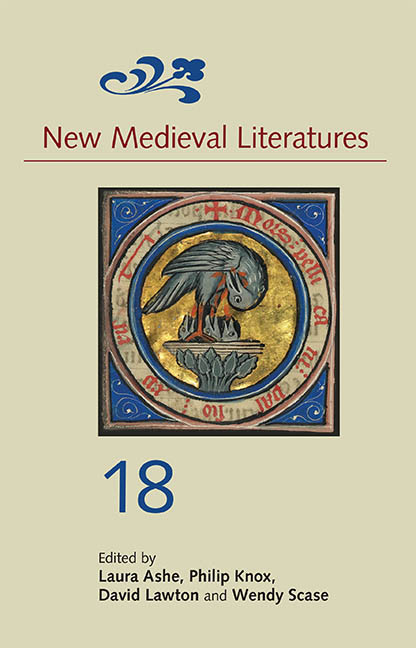Book contents
- Frontmatter
- Contents
- List of Illustrations
- List of Abbreviations
- 1 Arachnophobia and Early English Literature
- 2 Demonic Daydreams: Mind-Wandering and Mental Imagery in the Medieval Hagiography of St Dunstan
- 3 The Songs of Godric of Finchale: Vernacular Liturgy and Literary History
- 4 Sympathy for the Demon: Affective Instruction in the Katherine Group
- 5 Peynte it with Aves: Langland's Hawks, covetise, and Hugh of Fouilloy's Aviarium
- 6 Similes We Cure By: The Poetics of Late Medieval Medical Texts
- 7 The Life of Job: Bible Translation, Poem or Play?
2 - Demonic Daydreams: Mind-Wandering and Mental Imagery in the Medieval Hagiography of St Dunstan
Published online by Cambridge University Press: 03 July 2019
- Frontmatter
- Contents
- List of Illustrations
- List of Abbreviations
- 1 Arachnophobia and Early English Literature
- 2 Demonic Daydreams: Mind-Wandering and Mental Imagery in the Medieval Hagiography of St Dunstan
- 3 The Songs of Godric of Finchale: Vernacular Liturgy and Literary History
- 4 Sympathy for the Demon: Affective Instruction in the Katherine Group
- 5 Peynte it with Aves: Langland's Hawks, covetise, and Hugh of Fouilloy's Aviarium
- 6 Similes We Cure By: The Poetics of Late Medieval Medical Texts
- 7 The Life of Job: Bible Translation, Poem or Play?
Summary
St Dunstan stood in his ivied tower,
Alembic, crucible, all were there;
When in came Nick to play him a trick,
In guise of a damsel passing fair.
Every one knows How the story goes:
He took up the tongs and caught hold of his nose.
Richard Harris Barham was correct in his 1837 lay lampooning the legend of St Dunstan: the tale of the saint tweaking the devil's nose was indeed one which everyone knew. In fact, so famous was the tale that Barham felt it needed no further explanation. Few in the nineteenth century, however, could have known of its origins, nor indeed have imagined its novelty when the story first entered the hagiographical tradition in the final decade of the eleventh century. St Dunstan (909–988) had been dead for over a century and at least two different accounts of his Life had already been written, but Osbern of Canterbury was the first to tell this tale in his Vita S. Dunstani, written c. 1090. This essay explores the origins of this story, addresses why Osbern chose to introduce it into the legend of Dunstan, and asks what his careful remodelling of the tale can reveal about the purposes of hagiographical narratives.
The Historical Context
When Dunstan, former abbot of Glastonbury and archbishop of Canterbury, died in 988, he was swiftly championed as a saint. Within a decade a secular cleric and personal friend of Dunstan from his Glastonbury years, known only by the initial ‘B’, had written a Vita and shortly afterwards Adelard, a monk from St Peter's monastery, Ghent, revised this text into a set of twelve liturgical lessons. When Osbern came to write his Vita shortly after 1090, he primarily relied on these two earlier Lives, to which he made a variety of alterations. He repeatedly supplemented and embellished the existing legend and even, as in the case of this tale, introduced entirely new material.
Although a recent addition, the story quickly acquired canonical status and became an integral feature of the legend; it is conceivable that Osbern added it precisely because of its capacity to capture the imagination. Eadmer of Canterbury reworked it some fifteen years later, and William of Malmesbury incorporated it into his Vita S. Dunstani (written c. 1129–30); by the fourteenth century abridged versions of the story were circulating in both Latin and Middle English Legendaries.
- Type
- Chapter
- Information
- New Medieval Literatures 18 , pp. 44 - 74Publisher: Boydell & BrewerPrint publication year: 2018
- 3
- Cited by

